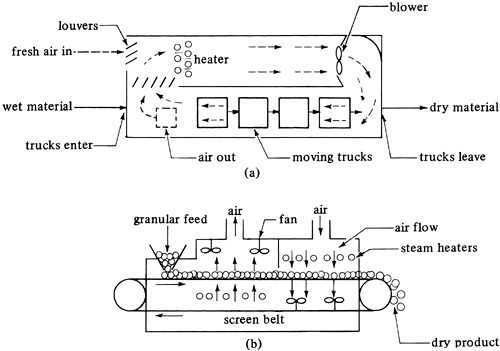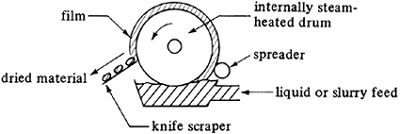9.2. EQUIPMENT FOR DRYING
9.2A. Tray Dryer
In tray dryers, which are also called shelf, cabinet, or compartment dryers, the material, which may be a lumpy solid or a pasty solid, is spread uniformly on a metal tray to a depth of 10 to 100 mm. Such a typical tray dryer, shown in Fig. 9.2-1, contains removable trays loaded in a cabinet.
Figure 9.2-1. Tray or shelf dryer.

Steam-heated air is recirculated by a fan over and parallel to the surface of the trays. Electrical heat is also used, especially for low heating loads. About 10 to 20% of the air passing over the trays is fresh air, the remainder being recirculated air.
After drying, the cabinet is opened and the trays are replaced with a new batch of trays. A modification of this type is the tray–truck type, where trays are loaded on trucks which are pushed into the dryer. This saves considerable time, since the trucks can be loaded and unloaded outside the dryer.
In the case of granular materials, the material can be loaded on screens which form the bottom of each tray. Then, in this through-circulation dryer, heated air passes through the permeable bed, yielding shorter drying times because of the greater surface area exposed to the air.
9.2B. Vacuum-Shelf Indirect Dryers
Vacuum-shelf dryers are indirectly heated batch dryers similar to tray dryers. Such a dryer consists of a cabinet made of cast-iron or steel plates with tightly fitted doors so that it can be operated under vacuum. Hollow shelves of steel are fastened permanently inside the chamber and are connected in parallel to inlet and outlet steam headers. The trays containing the solids to be dried rest upon the hollow shelves. The heat is conducted through the metal walls and aided by radiation from the shelf above. For low-temperature operation, circulating warm water is used instead of steam for furnishing the heat to vaporize the moisture. The vapors usually pass to a condenser.
These dryers are used to dry expensive or temperature-sensitive or easily oxidizable materials. They are useful for handling materials with toxic or valuable solvents.
9.2C. Continuous Tunnel Dryers
Continuous tunnel dryers are often batch truck or tray compartments operated in series, as shown in Fig. 9.2-2a. The solids are placed on trays or on trucks which move continuously through a tunnel with hot gases passing over the surface of each tray. The hot air flow can be countercurrent, cocurrent, or a combination. Many foods are dried in this way.
Figure 9.2-2. Continuous tunnel dryers: (a) tunnel dryer trucks with countercurrent air flow, (b) through-circulation screen conveyor dryer.

When granular particles of solids are to be dried, perforated or screen-belt continuous conveyors are often used, as in Fig. 9.2-2b. The wet granular solids are conveyed as a layer 25 to about 150 mm deep on a screen or perforated apron while heated air is blown upward through the bed or downward. The dryer consists of several sections in series, each with a fan and heating coils. A portion of the air is exhausted to the atmosphere by a fan. In some cases pasty materials can be preformed into cylinders and placed on the bed to be dried.
9.2D. Rotary Dryers
A rotary dryer consists of a hollow cylinder which is rotated and usually slightly inclined toward the outlet. The wet granular solids are fed at the high end as shown in Fig. 9.2-3 and move through the shell as it rotates. The heating shown is by direct contact with hot gases in countercurrent flow. In some cases the heating is by indirect contact through the heated wall of the cylinder.
Figure 9.2.3. Schematic drawing of a direct-heat rotary dryer.

The granular particles move forward slowly a short distance before they are showered downward through the hot gases as shown. Many other variations of this rotary dryer are available; these are discussed elsewhere (P1).
9.2E. Drum Dryers
A drum dryer consists of a heated metal roll, shown in Fig. 9.2-4, on the outside of which a thin layer of liquid or slurry is evaporated to dryness. The final dry solid is scraped off the roll, which is revolving slowly.
Figure 9.2.4. Rotary-drum dryer.

Drum dryers are suitable for handling slurries or pastes of solids in fine suspension and for solutions. The drum functions partly as an evaporator as well as a dryer. Other variations of the single-drum type are twin rotating drums with dip feeding or with top feeding to the two drums. Potato slurry is dried using drum dryers, to give potato flakes.
9.2F. Spray Dryers
In a spray dryer a liquid or slurry solution is sprayed into a hot gas stream in the form of a mist of fine droplets. The water is rapidly vaporized from the droplets, leaving particles of dry solid which are separated from the gas stream. The flow of gas and liquid in the spray chamber may be countercurrent, cocurrent, or a combination.
The fine droplets are formed from the liquid feed by spray nozzles or high-speed rotating spray disks inside a cylindrical chamber, as shown in Fig. 9.2-5. It is necessary to ensure that the droplets or wet particles of solid do not strike and stick to solid surfaces before drying has taken place; hence, large chambers are used. The dried solids leave at the bottom of the chamber through a screw conveyor. The exhaust gases flow through a cyclone separator to remove any fines. The particles produced are usually light and quite porous. Dried milk powder is made from spray-drying milk.
Figure 9.2-5. Process flow diagram of spray-drying apparatus.

9.2G. Drying of Crops and Grains
In the drying of grain from a harvest, the grain contains about 30 to 35% moisture, and for safe storage for about 1 year should be dried to about 13 wt % moisture (H1). A typical continuous-flow dryer is shown in Fig. 9.2-6. In the drying bin the thickness of the layer of grain, through which the hot air passes, is 0.5 m or less. Unheated air in the bottom section cools the dry grain before it leaves. Other types of crop dryers and storage bins are described by Hall (H1).
Figure 9.2-6. Vertical continuous-flow grain dryer.

